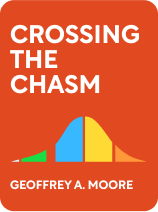

This article is an excerpt from the Shortform book guide to "Crossing the Chasm" by Geoffrey Moore. Shortform has the world's best summaries and analyses of books you should be reading.
Like this article? Sign up for a free trial here .
Why do people buy technology products? What are the different types of tech buyers?
If you are in the business of selling technology, you’d know there is a huge adoption gap between tech users. Some are in the line for the latest model the first day it drops while others only give in when the old tech is either broken beyond repair or obsolete.
In this article, we’ll take a look at the four critical factors that drive the purchasing decisions of tech customers.
Four Critical Factors
1. Compulsion Factor: When it comes to selling technology, the most important factor is whether the financial consequences of the problem your product solves are severe enough to compel the economic buyer to make the purchase. If they aren’t, then Moore says they will probably express curiosity about your product but not actually buy it. In this case, the scenario can be eliminated.
(Shortform note: In The Way of the Wolf, Jordan Belfort argues that you can sell anything to anyone, provided you can bring them to a point of complete confidence in the product, the seller, and the manufacturer. However, Moore’s observation implies that Belfort’s model is incomplete. The customer could be confident in the quality of the product, the integrity of the distributor, and the company behind the product, but they still won’t buy it if they don’t believe they need it. Thus, before you worry about creating confidence in the product or the seller, you need to create confidence in the severity of the problem that the product solves.)
2. Accessibility Factor: Next, Moore questions whether the hypothetical customers, especially the economic buyer in this scenario, actually exist, and can be reached effectively through an available sales channels. If not, the scenario can be eliminated.
3. Completeness Factor: According to Moore, another critical factor is whether you can actually deliver the whole product. Moore advises that if you can’t be ready to deliver it within three months, the scenario should be eliminated.
(Shortform note: Business bloggers often recommend keeping product launch schedules within a four-month time frame. Moore’s three-month limit on assembling the whole product implies a similar time frame for launching your whole product. While these numbers may seem arbitrary, the fact that different experts intuitively agree on similar time frames gives them more credibility.)
4. Competition Factor: Finally, Moore considers whether there are already direct competitors in this niche. If so, he says that puts you at enough of a disadvantage to warrant eliminating this scenario.
(Shortform note: Moore’s fourth critical factor for scenario selection is a key tenet of Blue Ocean Strategy, which advises that your product must provide unique value to your customers, implying there are no current competitors providing the same value.)

———End of Preview———
Like what you just read? Read the rest of the world's best book summary and analysis of Geoffrey Moore's "Crossing the Chasm" at Shortform .
Here's what you'll find in our full Crossing the Chasm summary :
- An explanation of the chasm phenomenon that many new high-tech products face
- How to pilot a product across this chasm to mainstream success
- The problems with the Technology Adoption Life Cycle (TALC) model






